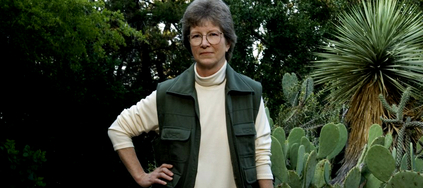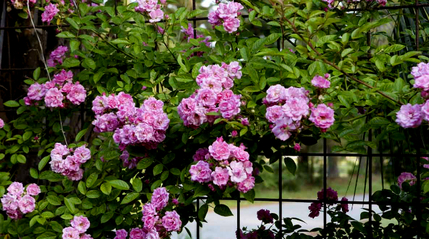
tel: 512 280-1192 Friday, April 11 2014
Nursery Notes: Great selection of vegetables, annuals, perennials.
Also fruit trees: figs, pears, apples, peaches, and plums are awe-
some, 6 to 8 feet tall $34.99. Plenty of organic fertilizers, composts
on hand. Bougainvillea and million belle baskets are beautiful. Also
come see our vegetable garden displays!
(Apologies if you received this email yesterday, and now again to-
day. There were some problems with yahoo and our email service)

Best-selling author Susan Wittig Albert returns to the nursery this
Sunday at 3 p.m. in a talk which will explore 'The Mystery of Herbs.'
(Free.) She will also be selling and signing copies of her novels.
_____________________________________________________
Cocktail Season: 'Spring in Austin means it’s time to delight in the
lush colors of new growth before the Texas summer mutes the hues
to browns and tans,' writes Kate Payne in the latest issue of Edible
Austin. 'For me, making the most of spring entails finding new ways
to use the beautiful flowers, fruit and foliage popping up all around,
and beverages are a wonderful, refreshing place to make spring
flavors sing.' Five cocktails for Spring
_____________________________________________________
Texas A&M Anniversary: The university's Vegetable & Fruit
Improvement Center - which brought us the Texas 1015 onion, the
maroon carrot, and 38 other new vegetable and fruit varieties -
celebrates it's 20th birthday this month. The New York Times
_____________________________________________________Central Texas Gardener: Learn how to swap invasive plants for
prettier native species that restore wildlife diversity. On tour, a family
unearthed native secrets when they pulled out the invaders. Sat. noon,
4 p.m. or Sun., 9 a.m. www.klru

Katrina survivor Peggy Martin, a beautiful thornless climber.
A Guide to Rose Classification
by Amanda Moon
Roses can be a beautiful, easily grown addition to any yard that has
lots of sun and room for them to grow. (To thrive they need a mini-
mum of 6-8 hours sunshine.)
But within the rose family there are different groups and classes,
and if you understand these, you’ll have a better understanding of
which roses will work best in your yard, and which ones will give
you the shape, color or fragrance that you’re looking for.
Roses are divided into three main groups: antiques, old garden, and
modern. The groups are then divided into classes. These give us an
idea of how a rose will grow, bloom and thrive in a particular area.
Some classes, for example, do best with a heavy pruning every year,
and others are better left alone.
_____________________________________________________
Antique Roses: This class contains roses that were introduced
before 1867, when the first hybrid tea rose, La France, was intro-
duced. In some cases many of these roses have been grown some-
where on this planet for more than 1000 years. So you could say
those still in production are the ultimate tried and true.
Tea roses are the predecessors of our modern hybrid teas. They have
larger blooms full of petals with a high center common with florist
roses. The buds are smaller than hybrid teas and the stems shorter,
but most tea roses have a wonderful light fragrance. The bushes tend
to be large and round and they bloom heavily in the spring and fall.
China roses are one of my favorite rose classes. They are sturdy and
can bloom nine months out of the year. Generally large shrubs (with
some climbers) they are hardy and drought resistant. This is one of
the classes found on abandoned homesteads throughout the state.
The best thing about bourbon roses is their amazing, heady fragrance.
Bourbons can be large shrubs, climbers or smaller more manageable
bushes.
Polyantha roses are smaller bushes, with smaller flowers borne in
clusters at the end of the branches. They bloom profusely and are
very easy to take care of.
_____________________________________________________
Old Garden Roses: Though not technically antiques, these roses
have been around long enough to have proven their mettle in our
tough climate.
Hybrid Musk roses really hit their stride starting in the 1920s. They
are large shrubs that can also be trained as small climbers and can
take five hours of sun a day and still bloom well. They have a nice
musky fragrance and bloom in clusters. My family has several musk
roses that have been passed down for more than 60 years.
Older Hybrid Teas have been around so long that they’re now group-
ed in with the other antiques and old fashioned roses. They tend to
have longer stems and higher centers than the tea roses. Some of
their blooms, like Peace, can be quite large and showy. They also
have more of an upright, slender growth habit than their predecessors.
_____________________________________________________
Modern Roses: This is the ‘everything else’ group. These roses
are more recently developed than the previous group, but still contain
some great rose varieties. It is with the modern roses that we start
to see the huge full flowers that florists crave and the vibrant colors
not seen in antique and older roses. Oranges and bright yellows espe-
cially make their mark with the newer introductions.
Shrub roses were never meant to be classified. They were developed
to grow and behave like blooming shrubs. Knock Out roses are prob-
ably the best examples of this class. They are for the most part disease
resistant, fast growing and heavy blooming.
Hybrid Teas and Grandifloras are two classes of roses developed
for their flowers. They have large, full, bright flowers on long
stems. . . perfect for floral arranging. They can require a little
more care than other classes and need yearly hard pruning, but they
can’t be beat for their blooms.
Floribunda roses are best thought of as the original shrub roses.
These are smaller bushes (under 4’ typically) with lots of blooms.
They usually perform very well with little oversight and don’t need
much pruning except to keep their shape.
Here are some of the beautiful roses that we are carrying this year
at the nursery: J.F. Kennedy, Mr. Lincoln, Dame de Coeur, Queen
Elizabeth, Old Blush (shrub and climbing), Red Cascade, Maggie,
Cecile Brunner, Livin’ Easy, Julia Child, Iceberg (shrub and climb-
ing), Penelope, Lavender Lassie, Marie Pavie and Belinda’s Dream.
Last but not least, an amazing tale of survival known as Peggy Martin.
This rose was discovered after Katrina had ravaged its’ homesite,
where she had sat for weeks under brackish water only to come out
alive on the other side. This thornless, climbing rose has gained
traction over the last 8 seasons because of this resilience and is a
fine addition to any landscape. Happy rose gardening everyone!
 Visit the website: www.itsaboutthyme.com
Visit the website: www.itsaboutthyme.com Visit the nursery:11726 Manchaca Road, Austin, 78748 Like us
on facebook